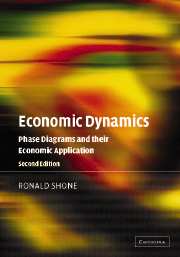Book contents
- Frontmatter
- Contents
- Preface to the second edition
- Preface to the first edition
- PART I Dynamic modelling
- PART II Applied economic dynamics
- 8 Demand and supply models
- 9 Dynamic theory of oligopoly
- 10 Closed economy dynamics
- 11 The dynamics of inflation and unemployment
- 12 Open economy dynamics: sticky price models
- 13 Open economy dynamics: flexible price models
- 14 Population models
- 15 The dynamics of fisheries
- Answers to selected exercises
- Bibliography
- Author index
- Subject index
9 - Dynamic theory of oligopoly
Published online by Cambridge University Press: 05 June 2012
- Frontmatter
- Contents
- Preface to the second edition
- Preface to the first edition
- PART I Dynamic modelling
- PART II Applied economic dynamics
- 8 Demand and supply models
- 9 Dynamic theory of oligopoly
- 10 Closed economy dynamics
- 11 The dynamics of inflation and unemployment
- 12 Open economy dynamics: sticky price models
- 13 Open economy dynamics: flexible price models
- 14 Population models
- 15 The dynamics of fisheries
- Answers to selected exercises
- Bibliography
- Author index
- Subject index
Summary
Very few topics in the theory of the firm have been considered from a dynamic point of view. There has been some work on the dynamics of advertising and the topic of diffusion (see Shone 2001). One topic that has been considered is the stability of the Cournot solution in oligopoly. Even this topic, however, is rarely treated in intermediate microeconomics textbooks. We shall try to redress this balance in this chapter and consider in some detail the dynamics of oligopoly, both discrete and continuous versions.
To highlight a number of the issues discussed in the literature, we concentrate on a single simple example. We outline first the static result that is found in most intermediate textbooks. Here, however, we utilise the mathematical packages in order to derive the results and especially the graphical output. We then turn to the dynamics. From the very outset it is important to be clear on the dynamic assumptions made. In the spirit of Cournot (see Friedman 1983, Gandolfo 1997) in each time period each firm recalls the choices made by itself and other firms in the industry. Furthermore, each firm assumes that in time period t its rivals will choose the same output level they chose in time period t - 1, and chooses its own output so as to maximise its profits at time t. This is by no means the only dynamic specification. It assumes that output adjusts completely and instantaneously.
- Type
- Chapter
- Information
- Economic DynamicsPhase Diagrams and their Economic Application, pp. 375 - 423Publisher: Cambridge University PressPrint publication year: 2002

